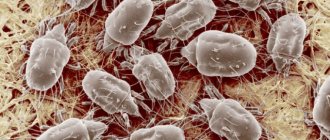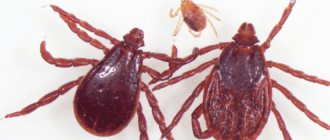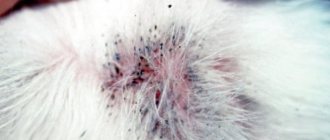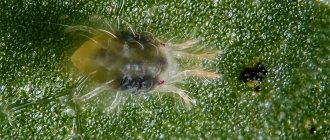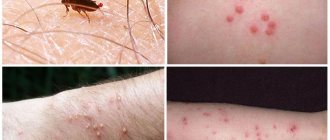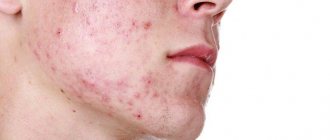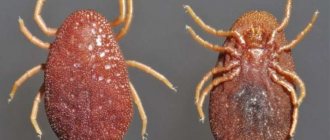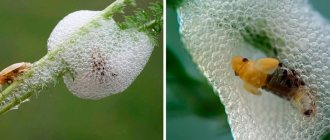The manifestation of unpleasant symptoms on the skin is very often the result of damage by skin mites. This type of disease greatly worries many people who have encountered this type of tick. Skin mites on the face cause especially a lot of discomfort.
Infection occurs very quickly and spreads throughout the entire face, including the hair growth area. A large number of external environmental factors and problems with the functioning of internal organs can lead to the appearance of this type of skin disease.
Skin mites do not disappear on their own; eliminating them requires the use of special medications and timely examination. If left untreated, the condition may deteriorate and a large area of the body may be affected.
What is demodex?
The appearance of skin mites is referred to in medicine as demodex. It is impossible to see such an organism with the naked eye; the skin mite is microscopic in size and is most often localized in the face, neck, chest and shoulders.
Features of Demodex:
- The largest number of skin mites is found in the sebaceous glands;
- In humans, skin mites can live for a long time in the upper layers of the skin and not cause any unpleasant symptoms;
- After weakening of the immune system or in the event of a violation of the protective functions of the skin, the tick has the ability to penetrate into the deep layers and form purulent, inflamed formations;
- Women most often suffer from this type of skin disease;
- To identify the type of disease, it is necessary to undergo a special type of diagnosis, during which the source of unpleasant symptoms will be identified.
Externally on the skin, a skin mite most often appears in the form of pimples with the presence of pus or subcutaneous nodules, which after some time become inflamed and increase in size.
What does a tick look like?
Examining the components of inflamed formations under a microscope, you can see:
- The demodex mite is a type of glandular acne, the reproduction of which occurs in the sebaceous glands;
- Outwardly it resembles a thin transparent worm;
- The tick's shell has no color, but is dense;
- The size of the tick is on average 0.4 mm;
- The skin mite moves with the help of scales;
- Demodex feeds on skin cells and subcutaneous fat.
Demodex most often exhibits its activity at night or during the development of diseases that reduce immunity.
Epidemiology of demodicosis
Source of infection
The main source of demodex mites are sick people or carriers.
Distribution routes
- Iron mites can be transmitted through bedding, underwear, and personal items. The parasites were found in house dust, the source of which was bedding.
- Some researchers suggest that ticks can get on a child during breastfeeding from a sick mother.
Sustainability
Constant humidity, darkness and air temperature within 30-40°C are optimal conditions for iron mites. Outside the host, at room temperature, constant humidity and in the dark, ticks live up to 9 days.
According to the observation of some researchers, parasites remain viable in water for 7 days, and up to 2 weeks in immersion oil.
Rice. 6. Demodex mite under a microscope.
Source and causes of occurrence
The mite can live on the skin and hair of almost every second person.
However, under normal conditions of functioning of internal organs, further spread of the tick does not occur. This disease is also called demodicosis.
The causes of the disease are as follows:
- Disruption of the digestive organs;
- Frequent nervous breakdowns;
- Insufficient or excessive skin care;
- Incorrectly selected cosmetics;
- Excessive use of saunas and solariums;
- Excessive coffee consumption and bad habits;
- Spicy food;
- Decreased functioning of the endocrine gland.
You can also become infected with a tick through close contact with a sick person, for example, sharing a bed or sharing cosmetics. The disease cannot be transmitted by air or other types of contact.
Life cycle
The entire life course of a worm-like mite can be divided into two periods of existence:
- intradermal (maturation and reproduction)
- extracutaneous or cutaneous
The mite, fixed on the walls of the excretory ducts, reaches a sexually mature state, is fertilized, and lays eggs. This concludes the ripening period.
Then a cutaneous, metamorphic period takes place outside. The eggs reach the surface of the dermis with a current of sebum. The larvae that emerge from them settle under the scales of the epidermis, in the mouths of the hair follicles. Molting (metamorphosis) takes place there - protonymph and teleonymph.
Subsequently, adults roll down the excretory duct of the sebaceous glands, and the cycle begins again. Fertilization is internal; individuals mate at the mouth of the follicle. In total, the life cycle takes 15-25 days.
Signs and symptoms of the disease
Very often, mite infestation is confused with acne and the correct treatment is not used.
Demodex manifests itself with the following first signs:
- The skin becomes oilier and visual enlargement of pores is observed;
- Formation of places on the skin with an increased level of shine;
- Redness and swelling of the skin;
- Itching at night;
- The appearance of scales on the eyelashes, which can lead to burning and itching.
After infection, the following unpleasant symptoms occur:
- Inflammation and swelling of certain areas of the skin;
- The appearance of red bumps;
- Hair loss and itching on the scalp;
- The appearance of pimples in large numbers with purulent inclusions;
- Puffiness of the eyes;
- Formation of ulcers;
- The appearance of plaque in the area of hair growth.
Symptoms may appear in isolated cases or with a high level of distribution in healthy areas of the skin.
Stages of development
Depending on the number of mites and the degree of their progression in the deep layers of the epidermis, different stages of the disease are distinguished.
Such as:
- The prodromal stage is the first stage when a tick infection has just occurred. During this period, practically no unpleasant symptoms are felt; the disease can only be identified using special diagnostic methods. This period is considered the most optimal for the complete elimination of the skin disease. The very first symptoms are slight redness of the skin in the areas where the sebaceous glands are located;
- Erymatous stage - the disease begins to progress and a person can already visually observe the first visible symptoms, such as swelling and the formation of purulent pimples. This stage can be treated without the use of complex therapy;
- The papulopustular stage is a more complex stage of the development of the disease, which manifests itself in the form of a large number of pimples, accompanied by specific itching and inflammation of the skin. Treatment requires special examination and observation by the attending physician;
- The hypertrophic stage is considered the most complex course of the disease, which is manifested by large inflamed formations containing pus. At this stage, it is almost impossible to eliminate the disease.
To prevent the development of complex stages of the disease, it is recommended to seek help in a timely manner and not self-medicate.
Clinical variants of demodicosis
Demodicosis in humans can develop as a primary independent disease, or it develops against the background of existing skin diseases (perioral dermatitis, rosacea, acne, seborrheic dermatitis, etc.), aggravating their course.
Primary demodicosis
In primary demodicosis, inflammatory skin elements resolve after antiparasitic therapy. About 40% of cases of primary demodicosis develop in patients suffering from rosacea.
Primary demodicosis is characterized by:
- the onset of the disease over the age of 40 years;
- The areas most often affected are around the mouth, eyes and outer ear;
- inflammatory elements are located asymmetrically and are accompanied by itching;
- acne and rosacea are absent;
- high content of mites on the skin;
- positive effect of the antiparasitic treatment.
Secondary demodicosis
Secondary demodicosis develops against the background of diseases accompanied by a sharp suppression of the immune system (HIV infection, leukemia, etc.), long-term use of corticosteroids and cytotoxic therapy, or develops against the background of acne and rosacea, complicating their course. This form of the disease is registered in 33% of patients with acne.
Secondary demodicosis is characterized by:
- the disease appears at any age;
- lesions are widespread;
- presence of anamnesis and clinical picture of relevant diseases.
Papulopustular rashes on the skin of the face are a reason for diagnosing demodicosis.
Rice. 8. Demodectic mange on a woman’s face.
What triggers the growth of subcutaneous mites?
The following factors lead to the rapid growth and reproduction of ticks:
- Improper skin care;
- Insufficient intake of vitamins;
- Disease of internal organs;
- Lack of treatment for skin mites;
- Use of antibiotics;
- Dysbacteriosis;
- External negative factors.
In addition, increased activity of the sebaceous glands increases the growth of the mite, which can occur as a result of excessive use of products containing alcohol.
Routes of infection
Subcutaneous mites are not always activated in the human body due to health problems or poor immunity; in some cases, accidental infection with these parasites is possible. Such infection can occur in the following ways:
- Personal hygiene products, cosmetics or bedding if they were used by an infected person.
- Contact with the sebaceous glands or hair of an infected person.
- Using non-sterile instruments in hairdressing or massage parlors.
Diagnostics
To identify the stage of development, it is necessary to carry out special diagnostic methods:
- Scraping from the site of inflammation - using a scalpel, carefully take a scraping from the affected areas of the skin;
- Eyelash test - several eyelashes from both eyes are taken for analysis;
- Using adhesive tape , which is glued to the affected area for a certain time, after which it is checked for the presence of ticks.
After receiving the tests, the doctor prescribes the necessary treatment and diet to improve the general condition of the body.
How to get rid of subcutaneous mites?
To eliminate skin mites, it is recommended to use the following treatment methods:
- Medicinal treatment of the problem helps eliminate the disease and reduce unpleasant symptoms. Prescribed strictly by the attending physician depending on the degree of development of the disease;
- Cryotherapy - aimed at restoring cells that were damaged by the tick and blocking the further development of the disease;
- Following a special diet can improve the condition of the skin and increase immunity;
- Traditional medicine - the use of traditional medicine methods can reduce unpleasant symptoms and prevent further development of the disease.
Most often, to eliminate the disease, it is recommended to use complex therapy, which will not only eliminate the disease, but also reduce the manifestation of the consequences after the disease.
Drug treatment
To eliminate ticks by medication, the following types of medications are prescribed.
Antiparasitic drugs
Allows you to reduce the development of skin mites in the layers of the epidermis and improve the natural processes of cell regeneration.
The most popular of them:
- Metronidazole is a drug for external use prescribed to eliminate ticks. Apply twice a day directly to the affected areas. Used from 12 years of age, the course of treatment is prescribed individually for each patient. The cost of the ointment is 140 rubles ;
- Benzyl benzoate , a substance in solution form, is widely used to eliminate many types of epidermal diseases. Destroys the integrity of microorganism cells, thereby eliminating the mite. Apply twice a day to problem areas of the body. The course of treatment is no more than 21 days. Not applicable until age 10 years. Avoid contact with mucous membranes; it may cause a strong burning sensation. Average cost 60 rubles ;
- Sulfur ointment – improves skin condition, fights various types of skin parasites. Apply once a day before bedtime. It is recommended to rub the ointment until completely absorbed. Can be used from the age of 5 years. Cost 45 rubles .
Metronidazole
Benzyl benzoate
Sulfuric ointment
Antibiotics
Used for more complex types of disease development. Prescribed to block further spread of the disease and reduce recurrence.
The most effective antibiotics:
- Trichopolum - has a broad effect on the problem. Blocks the possibility of movement of parasites, thereby reducing their further reproduction. Use 1 tablet for 10 days. Prohibited during pregnancy, liver and kidney dysfunction. Cost 180 rubles ;
- Rozamet is a cream for external use that contains the antibiotic metronidazole and helps reduce the reproduction of the parasite. Use twice a day for a course of no more than 1 month. Contraindicated for pregnant women and under 12 years of age. Price 220 rubles ;
- Aversectin ointment - allows you to quickly eliminate the tick. Use once a day on damaged areas. The course of treatment is no more than 10 days. Use with caution for people with sensitive skin and during pregnancy. Has the property of causing side effects. Price 60 rubles .
Trichopolum
Rozamet
Aversectin ointment
Restorative products for the body
Aimed at strengthening the protective functions of the immune system and activating the body's natural fight processes.
Most prescribed drugs:
- Lykopid - used to enhance the functions of the immune system, used once a day for 15 days. Price 300 rubles ;
- Vitamin complexes - required to increase immune resistance to various types of diseases, such as fish oil and vitamin D, for example Aquadetrim with an average price of 180 rubles .
Lycopid
Aquadetrim
Vascular strengthening agents
Necessary for strengthening blood vessels that are damaged as a result of tick activity. They are prescribed individually for each patient, if the attending physician considers this type of medicinal substance necessary.
Correctly selected medications can quickly reduce unpleasant symptoms and improve the overall condition of the skin.
Treatment with folk remedies
To eliminate demodex in the first stages of its development, various traditional medicine methods are often used, which help get rid of symptoms and block further progression of the disease.
The most commonly used healthy home recipes are:
- Washing with laundry soap helps clean the skin and reduce the movement of the parasite. It is recommended to wash your face three times with laundry soap. Effective in complex therapy with other types of folk remedies. Appointed from the age of 4 years;
- Ointment with gunpowder - mix gunpowder and butter in equal proportions, apply the mixture twice to damaged areas. The course of treatment is no more than 14 days. Permissible age of use is from 12 years;
- Wormwood tincture – reduces tick activity and blocks its further reproduction. Pour boiling water over the dry herb and leave for 30 minutes. Drink half a glass daily before meals. The duration of treatment is no more than 15 days. Contraindicated for children and during pregnancy;
- Aloe – grind aloe, add crushed streptocide tablet. Apply the resulting mixture to the skin daily for 2 weeks. Used from the age of 5 years;
- Birch tar – mix sulfur powder and birch tar in equal proportions. Apply daily before bed and leave for several hours. After removal, wash with tar soap. It prevents further reproduction of demodex and destroys the integrity of its shell. The course of application is up to 14 days.
The use of such methods requires regularity; before use, it is necessary to conduct an individual sensitivity test.
Non-drug treatments
The following treatment methods are widely used to remove demodex.
Application of medicinal cosmetics
It is used for daily care and prevents the emergence of new mites, and also reduces the external manifestations of the disease.
The most popular means:
- Demoten is a specially developed gel for external use that allows it to penetrate deeply into the layers of the skin and destroy parasite cells. Suitable for daily use. Effectively moisturizes and nourishes the skin. Applicable from the age of 14 years;
- Demodex foot cosmetics series - specially developed products contain special components that effectively fight mites and reduce external manifestations. The line of cosmetics includes cream, shampoo, and tonic. Suitable for daily use from 14 years of age. Not used for people with hypersensitive skin and during pregnancy;
- The Demodex Complex line of products contains natural herbal ingredients. They are used at different stages of disease development. Suitable for daily use from the age of 18 years.
Demoten
Stop Demodex Demodex Complex
Deep peeling
Produced in special cosmetology rooms.
The procedure has the following features:
- Fruit acids are used as a basis , which reduce the production of sebaceous glands;
- This cleanses the skin of dead cells and prevents the spread of mites.
This method is considered most effective for the initial symptoms of the disease. Do not use in the presence of wounds and inflamed formations.
Darsonval procedure
Used to improve the natural processes of the skin.
The procedure has the following features:
- The supply of oxygen to the cells improves protective functions and prevents the further spread of demodex;
- Before carrying out the procedure, it is recommended to undergo appropriate diagnostics and consult a doctor;
- It is prohibited to use any preparations for external use for several days before the procedure;
- Prohibited for people with hypersensitive skin and people with pacemakers;
- Suitable for ages 12 and up.
The procedure is carried out using a special device that emits small currents that activate skin cells.
Cryomassage
Carry out using liquid nitrogen.
The procedure has the following features:
- Under the influence of low temperature, ticks freeze, which leads to their death;
- The use of cryoprocedures will reduce external symptoms;
- The procedures are carried out until the disease disappears completely;
- It is recommended to use in combination with drug therapy.
Before the procedure, it is recommended to remove all medications from the skin; cold exposure is performed for at least 3 minutes. Prohibited during pregnancy and for people under 14 years of age.
Laser removal
It is used after drug treatment and effectively reduces the external manifestations of the disease.
The procedure has the following features:
- Using a laser beam, damaged cells are aligned and removed;
- Applicable from the age of 18;
- It is prohibited if there are wounds or inflammation on the skin; you should consult a doctor before the procedure.
Physiotherapy
Used to remove skin mites.
Features of the procedures:
- Electrophoresis is most often used to improve the protective functions of the skin;
- Applications with medications are used;
- Can be used from the age of 12 years.
Experts recommend using comprehensive approaches to eliminate the problem, and to carry them out strictly in special institutions.
Folk remedies
Remember that folk recipes can help with drug treatment. Separately, they are ineffective and one should not refuse the help of doctors, as this will aggravate the situation.
Celandine juice is quite effective, but it is not suitable for everyone, since it can cause allergic reactions. It is used in the treatment of scabies. To use it, you need to dilute the juice with water in a ratio of 1:2, then wipe the rash with a cotton swab.
For demodicosis, tea tree oil is used, which helps relieve itching, relieve burning and improve skin condition. To do this, you need to take body cream and add a few drops of oil to it. Juniper infusion is also used.
To prepare it you will need dry berries that need to be chopped. One tablespoon of crushed berries is poured into a glass of boiling water and left for 5 hours, then filtered and used for rubbing. To increase effectiveness, before wiping, you need to wipe the skin with calendula infusion, and then use the infusion as a compress, which should be kept for no more than 20 minutes.
In addition to drug treatment and the use of traditional methods, a very important point in therapy is proper nutrition.
Recommendations and useful tips for treatment
To achieve more visible treatment results, dermatologists advise following the following recommendations:
- Cleanse the skin daily with special preparations that eliminate excessive oily sheen;
- Do not use hot water for washing , this procedure disrupts the natural protective functions of the skin;
- Reduce skin touching , especially in the facial area. A person’s hands may contain a large number of bacteria that contribute to the disruption of the structure of the skin and can cause the development of mites;
- Ensure the cleanliness of personal hygiene products and items for applying cosmetics;
- Avoid prolonged exposure to direct sunlight;
- Replace the feather pillow with padding polyester , very often down can cause a reaction and provoke the occurrence of demodex;
- Do not apply cosmetics in large quantities ; this method of applying cosmetics leads to clogged pores and the development of skin mites.
Experts recommend following such facial care methods even in the absence of tick infestation, as well as during treatment with medications.
Special diet
When dealing with demodex disease, experts often advise following a certain type of diet.
First of all, you should exclude:
- Salty food;
- Fatty foods;
- Fried and spicy foods;
- Smoked meats and sausages;
- Sweets;
- Canned and fatty meats.
During the treatment period, it is recommended to focus on the following fruits:
- Apples;
- Pears;
- Banana;
- Grapefruit (small quantity)
- Pomegranate;
- Kiwi.
Consumption of citrus fruits is not recommended, as this can contribute to the development of allergic reactions and aggravate the disease.
It is also recommended to introduce fermented milk products and whole grain cereals into the diet. Saturating the body with foods that contain fiber can reduce the deposition of toxins and wastes and improve natural metabolic processes.
It is possible to defeat parasites!
Antiparasitic Complex® - Reliable and safe removal of parasites in 21 days!
- The composition includes only natural ingredients;
- Does not cause side effects;
- Absolutely safe;
- Protects the liver, heart, lungs, stomach, skin from parasites;
- Removes waste products of parasites from the body.
- Effectively destroys most types of helminths in 21 days.
There is now a preferential program for free packaging. Read expert opinion.
Read further:
Main types of streptococci: description and life cycle of development
Demodex brevis: structure of the parasite, diagnosis and how to treat
Life cycle of development of the human roundworm, stages of development of the parasite in the body
Tumbu fly (photo): description of the parasite, life cycle of larval development
Dermatobia Hominis: description, development cycle, symptoms and treatment
Taenia saginata: description of the parasite, life cycle of development, routes of infection and treatment
Reviews
Reviews about the treatment of skin mites:
Prevention measures
To prevent the occurrence of such an unpleasant disease as skin mites, it is recommended to follow the following prevention methods:
- Change bed linen regularly;
- Have a separate personal towel for your face;
- Do not use other people's personal hygiene products;
- Maintain proper nutrition, exercise outdoors;
- Treat diseases of internal organs in a timely manner;
- Take additional vitamin complexes;
- After treatment with antibiotics, use special drugs to restore the immune system;
- Use sunscreen when exposed to direct sunlight for long periods of time.
Regular adherence to prevention methods can eliminate the likelihood of tick infection.


